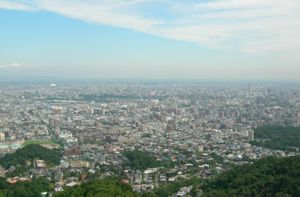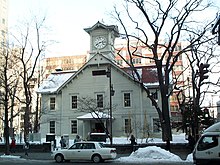Sapporo
| Sapporo-shi 札幌 市 |
||
|---|---|---|
| Geographical location in Japan | ||
|
|
||
| Region : | Hokkaidō | |
| Prefecture : | Hokkaidō | |
| Coordinates : | 43 ° 4 ' N , 141 ° 21' E | |
| Basic data | ||
| Surface: | 1,121.12 km² | |
| Residents : | 1,958,756 (September 30, 2019) |
|
| Population density : | 1747 inhabitants per km² | |
| Community key : | 01100-2 | |
| Symbols | ||
| Flag / coat of arms: | ||
| Tree : | Common lilac | |
| Flower : | lily of the valley | |
| Bird : | cuckoo | |
| town hall | ||
| Address : |
Sapporo City Hall 2 Kita-1-jō-nishi Chuo-ku , Sapporo -shi Hokkaido 060-8611 |
|
| Website URL: | http://www.city.sapporo.jp/ | |
| Location Sapporos in Hokkaidō Prefecture | ||
Sapporo ( Japanese 札幌 市 , - shi , from Ainu sat poro (pet) , dt. "Dry, large (river)") is the largest city of Hokkaidō , the northernmost of the four main Japanese islands , with 1.9 million inhabitants .
Sapporo is the administrative seat of the Hokkaidō Prefecture and the Ishikari Sub-prefecture .
history
Founded in the 19th century
Sapporo was founded in 1869 as the seat of the colonial administration of Hokkaidō , which has been part of Japan since the 19th century . It was not until the 1950s that it replaced the nearby and much older Otaru as the most populous city of Hokkaidō. Similar to Kyoto or many American cities, the city was planned in a checkerboard pattern.
Sapporo's Agricultural University , which was also founded in 1869 and initially based in Tokyo, was also made famous by its first president, William Smith Clark . He was invited by the Japanese government to act as an advisor on education issues. Above all, the farewell words to his students, many of whom he had converted to Christianity, left a lasting impression: Boys, be ambitious! (Eng. "Boys, be ambitious!").
Events from the 20th century
Sapporo was intended to be the venue for the Fifth Winter Olympics in 1940. As a result of the beginning of the Second Sino-Japanese War , Japan had to return the games to the IOC on July 16, 1938 .
Finally, the IOC awarded the 1972 Winter Olympics to Sapporo. That was the first Olympic Winter Games in Asia . Since then, combines a twinning Sapporo to Munich , the venue of the Olympic Games the same year.
On the occasion of this major international sporting event, the organizers introduced the Sapporo Snow Festival as part of the Olympic sports culture and thus fell back on an event that was widespread in the region. Here, invited artists created impressive sculptures out of snow and ice. This festival subsequently established itself as an annual event .
In 1978, when Sapporo tried to host the Winter Olympics a second time after 1972 , Sapporo only failed in the runoff election against Sarajevo .
Mayor Fumio Ueda gave up an originally planned application for the 2016 Summer Olympics against domestic Japanese rivals Fukuoka and Tokyo , citing the high costs in 2006. Another application to host the 2026 Winter Olympics was also withdrawn during the application process.
geography
Green spaces
The city of Sapporo has many parks. So z. B. Ōdōri Park in the city center, which hosts various annual events and festivals throughout the year. One of the largest parks in the city is Moerenuma Park, which was built according to the plans of the Japanese-American artist and landscape architect Isamu Noguchi .
City structureSapporo is divided into 10 boroughs ( ku ):
|
Neighboring cities and communities |
climate
| Sapporo | ||||||||||||||||||||||||||||||||||||||||||||||||
|---|---|---|---|---|---|---|---|---|---|---|---|---|---|---|---|---|---|---|---|---|---|---|---|---|---|---|---|---|---|---|---|---|---|---|---|---|---|---|---|---|---|---|---|---|---|---|---|---|
| Climate diagram | ||||||||||||||||||||||||||||||||||||||||||||||||
| ||||||||||||||||||||||||||||||||||||||||||||||||
|
Average monthly temperatures and rainfall for Sapporo
Source: Japan Meteorological Agency ; wetterkontor.de
|
|||||||||||||||||||||||||||||||||||||||||||||||||||||||||||||||||||||||||||||||||||||||||||||||||||||||||||||||||||||||||||||||||||||||||||||||||||||||||||||||||||||
Politics and administration
Mayor of the city
As in all Japanese municipalities, a mayor, directly elected by the residents, runs the administration and represents the city externally.
- Former center-left deputy mayor Katsuhiro Akimoto has been mayor of Sapporo (Sapporo-shichō) since 2015 . In the regional elections in April 2019 , with anti-communist all-party support ( KDP , DVP , Daichi , LDP , Kōmeitō , SDP ), he was re-elected for a second term with a two-thirds majority against the CPY-supported Tatsuo Watanabe.
City, Prefecture and Nation Parliaments
A city parliament elected by the residents with a total of 68 members forms the legislature.
(as of July 5, 2019)
- LDP : 27
- Minshu shimin rengō ("Democratic Citizens League"; mainly KDP ): 20
- Kōmeitō : 10
- KPY : 10
- Shimin Network Hokkaidō : 1
- In the new 68-member city council (Sapporo-shigikai) elected at the same time as the mayoral election as part of the 2019 unified elections , the Liberal Democratic Party remained the strongest force with 26 seats.
- In the prefectural parliament ( Hokkai-dōgikai ) , which was also elected at the same time , the ten constituencies that make up the ten districts of the city of Sapporo together elect 28 of the total of 100 members.
- In elections to the House of Representatives ( Shūgiin ) , the lower house of the national parliament , the city of Sapporo extends into the constituencies of Hokkaidō 1 to 5. The constituencies 1 to 3, which lie entirely in the city of Sapporo, elected the Liberal Democrat Takamori Yoshikawa and the constitutional officers in 2017 Democrats Daiki Michishita and Satoshi Arai .
Town twinning
In the 21st century the following partnerships exist with places from Europe, America and Asia; The year in which the partnership began is given in brackets:
- A traditional Bavarian maypole , a gift from the city of Munich, stands in Ōdōri-Park in the city center as a symbol of the partnership .
-
 Shenyang , People's Republic of China (since November 1980)
Shenyang , People's Republic of China (since November 1980) -
 Novosibirsk , Russia (since June 1990)
Novosibirsk , Russia (since June 1990) -
 Daejeon , Republic of Korea (since October 2010)
Daejeon , Republic of Korea (since October 2010)
Buildings and parks
Sapporo is a relatively young city whose few historical sights reveal the strong western influence during the Meiji Restoration :
- the clock tower of the former assembly hall of the agricultural university, which is considered the city's landmark (see above). The city's charter begins with the words: We are the citizens of the city of Sapporo, where the bell of the clock tower is ringing .
- the administrative building made of red clinker, which served as the official residence of the governor of Hokkaidō until the 1970s, today converted into the Sapporos Beer Museum.
- the ivy-covered buildings of the old Sapporo brewery from 1876, which were built in the same style and which have since been converted into the largest beer hall in Japan.
- the development village ( 北海道 開拓 の 村 開拓 の 村 , kaitaku no mura ), an open-air museum in which restored old buildings from all over Hokkaidō can be viewed .
- the television tower in steel framework construction.
- the Hokkaidō-jingū , Hokkaidō's largest Shintō shrine .
Regular events
Snow festival
Sapporo's biggest tourism event is the annual February Snow Festival ( 雪祭 り , yuki matsuri ), which began in 1950 when schoolchildren and students built statues out of snow in Ōdōri Park. The festival has now been extended to a week, and a dozen huge and hundreds of smaller snow and ice sculptures are being erected on three different sites , attracting hundreds of thousands of visitors. Huge means: up to 10 m high and 30 m wide, consisting of 1000 or more truckloads of snow. The most common motifs are more or less famous buildings from all over the world, which are often reproduced on a scale of 1: 3 or even 1: 2 with all the details, just made of snow or ice.
The large sculptures are sponsored by companies, some are also being built by the Japanese Self-Defense Forces as part of winter training. Local associations set up the smaller snow sculptures, and the demand is so great. The available space for the buildings will be raffled among the applicants. An international competition is also held.
see also: Moerenuma Park
traffic
- Sapporo Tram - commissioned in 1909, three lines
- Sapporo Metro - Opened in 1971, three lines
- Sapporo Station on the JR Hakodate Main Line
- New Chitose Airport
- Streets:
- Dōō Highway
- Sasson Highway
- National road 5
- National road 12
- National road 36
- National roads 230, 231, 274, 275, 337, 453
Sports
Sports buildings, sports clubs and events
- Makomanai Stadium and Makomanai Indoor Stadium
- Baseball - Sapporo is home to the Hokkaidō Nippon Ham Fighters baseball club of the Pacific League , whose games are played in the Sapporo Dome .
- Soccer - Sapporo is home to the J. League Consadole Sapporo soccer club , whose games are played in the Sapporo Dome . Three preliminary round matches were held here on the occasion of the 2002 World Cup .
- Sapporo Half Marathon and Hokkaidō Marathon
- Ski jumping, cross-country skiing, Nordic combined:
2020 Summer Olympics / Competitions
Due to the milder climate compared to Tokyo, the walking and marathon competitions of the 2020 Summer Olympics will be held in Sapporo.
Universities and colleges
Personalities
Sapporo in literature
In the novel Dance with the Sheepman , Haruki Murakami lets his protagonist have an encounter with the eponymous, enigmatic sheepman in a hotel in Sapporo and then maintains contact with an employee of the hotel.
Web links
- Sapporo , tabibito.de Japan Almanach (description, arrival, overnight stays, with numerous illustrations)
Individual evidence
- ↑ ふ る さ と の 川 史話 い っ ぱ い . City of Sapporo, accessed May 30, 2009 (Japanese).
- ↑ Volker Kluge : Olympic Winter Games. The Chronicle . 3rd, exp. Edition. Sportverlag, Berlin 1999, ISBN 3-328-00831-4 .
- ^ Japanese Olympic Committee: History of Japan's Bids for the Olympics .
- ↑ Sapporo opts out of '16 Games race. In: The Japan Times . February 22, 2006, accessed May 29, 2009 .
- ↑ Sapporo drops out as the third candidate. www.deutschlandfunk.de, 2018 .
- ↑ 統一 地方 選 2019 札幌 市長 選 . In: NHK Senkyo Web. April 8, 2019. Retrieved November 10, 2019 (Japanese).
- ^ Sapporo City Parliament: parliamentary groups , accessed on November 10, 2019.
- ↑ 統一 地方 選 2019 札幌 市 議 選 各 党 議席 . In: NHK Senkyo Web. April 8, 2019. Retrieved May 23, 2019 (Japanese).
- ^ Sister Cities / Sister Cities Association. Sapporo International Communication Plaza Foundation, 2014, accessed August 18, 2019 (Japanese, English, Chinese, Korean).
- ↑ Information about the Snow Festival (Japanese, English)
Information on the snow festival in Sapporo (German) ( Memento from February 4, 2015 in the Internet Archive ) Information on the snow festival in Sapporo (German) Japanica.de








